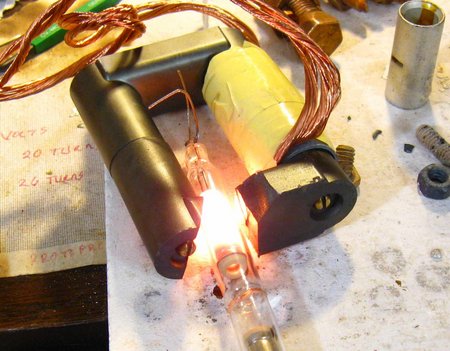Making neon signs and artwork is what got me started on the induction heater quest in the first place. So now we’ve come full circle. Most people won’t have any need to process neon signs, of course, but I post this installment just for the fun of it and to show some eye candy.
In making a neon sign unit, first the glass tubing is heated and bent to the desired shape. Then neon electrodes are attached. Finally the tube is processed to remove impurities and air and then to fill the tube with the noble gas (neon or argon) to make it glow. Part of the processing is the heating of the neon electrode to convert the electron emissive coating on the interior of the electrode to its active form.
Traditionally this has been done by passing a high voltage high current through the tube while partially evacuated. This heats the glass and the electrodes – a desirable occurrence. But the rate of glass heating and the rate of electrode heating is often different and that is not desired. Induction heating is the Better Way. That separates the glass heating from the electrode heating.
Here is a photo of an electrode being heated in the gap of the flux concentrator.
The induction heater is set to low power – about 400 watts. This is to avoid melting the trode and to make this video [2] more interesting. Full power heats the electrode in a flash.
